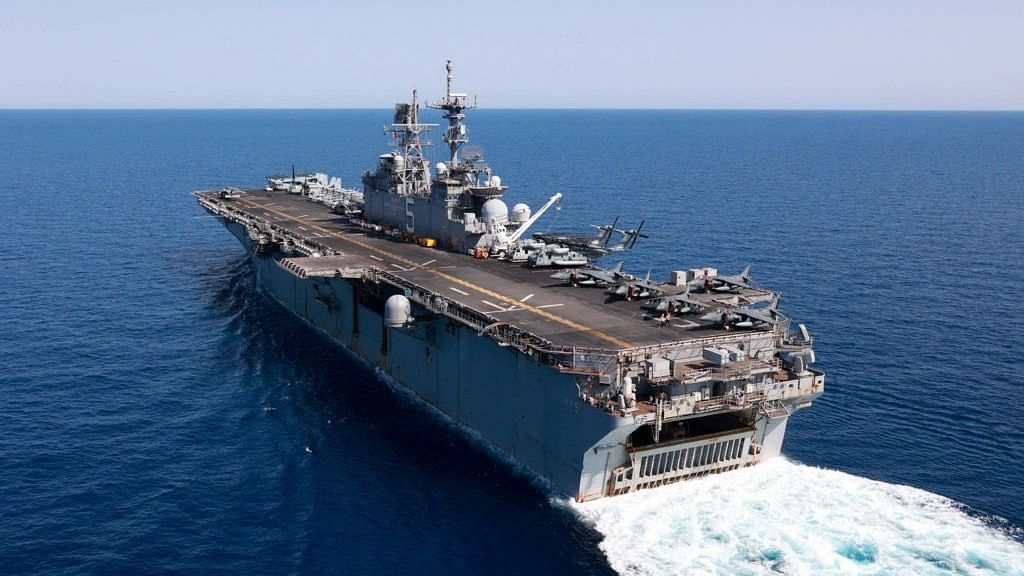
USS Bataan.
Credit: X/@sentdefenderSubscribe
By James Stavridis
Days after the arrival of a US armada off the coast of Israel, another three warships and a contingent of marines set off urgently in the same direction from Kuwait on Thursday and could be there by the middle of next week.
As there’s already a massive concentration of firepower in place, centered around the nuclear-powered aircraft carrier, USS Gerald R Ford, the additional forces raise questions about what capabilities will be available and how they could be used in the Gaza war.
The principal reason to consider speeding them to the scene of the crisis is the presence of so many US citizens in a war zone. There are roughly 200,000 Americans, mostly dual citizens, in Israel. In addition to the possibility of being caught in the crossfire between Israel and Hamas in the south, there is a very real risk of a wider conflict if Hezbollah – with the likely green light from Iran -- decides to join the fight from the north.
The administration will want more than the direct combat power of the USS Gerald R Ford aircraft carrier strike group. That may explain why the warships and Marines were ordered to cut short a training exercise that was scheduled to run through Oct 22 due to what the Pentagon called “emerging events.”
USS Bataan, at 40,000 tons and over 800 feet in length, is a smaller version of a nuclear-powered aircraft carrier. With conventional propulsion, she has a powerful airwing that typically includes six F-35 strike fighters (with vertical takeoff capability), alongside a dozen of the assault support tiltrotor MV-22 Ospreys to get Marines rapidly ashore in a crisis.
The ship also has very capable missile defense systems, surveillance radars and a crew of over 1,200 sailors. There is a complete medical and surgical operating facility, along with space to embark nearly 2,000 Marines. I’ve commanded these ships as both a NATO commander and earlier at US Southern Command, where we used them for medical diplomacy throughout Latin America and the Caribbean – but their real purpose is to support Marines in combat.
USS Carter Hall, also part of the amphibious group, is somewhat smaller at 16,000 tons and 600 feet in length, but she carriers a powerful punch of amphibious assault vehicles and landing craft. The third ship in the group, USS Mesa Verde, is a newer and larger version of Carter Hall, sized at roughly 25,000 tons.
In addition to the attack aircraft on the ships, the real offensive punch of the force is the 26th Marine Expeditionary Unit with more than 2,000 Marines. The MEU is configured for special operations, including a significant element of the vaunted Marine special operators, whose training resembles that of the Navy SEALs or the Army Green Berets.
Overall, the MEU has over 2,000 combat-trained Marines organized into an infantry battalion, an airwing to transport them, and embedded logistics support – everything from water purification systems to big tactical trucks and fast Humvees.
With a couple of thousand Marines nearby at sea, the President’s options will include securing airports for military and chartered commercial evacuation of Americans; guarding concentration points to collect citizens preparing to evacuate; securing coastal bases if air evacuation becomes too dangerous; and providing emergency medical support.
Above all, the special operations elements of the 26th MEU could be part of finding, fixing, and rescuing American hostages. This would obviously be done in complete coordination with Israeli special forces, and with a recognition that such operations are inherently dangerous and very often end with tragic outcomes for innocent hostages. It would most likely include US tier-one special forces, the elite SEALs and Green Berets operating globally out of Fort Liberty, North Carolina.
This all sounds like the culmination of a Tom Clancy novel, and all of this will be controversial in terms of potentially having actual US boots on the ground and fighter jets and helicopters in the skies above the fight in Gaza. But the highest obligation of a President is to protect American lives, and if events spiral into an even higher level of violence in Israel, the presence of US Marines gives the administration more and better options to respond. Send in the Marines.
Stavridis is also vice chairman of global affairs at the Carlyle Group. He is on the boards of American Water Works, Fortinet, PreVeil, NFP, Ankura Consulting Group, Titan Holdings, Michael Baker and Neuberger Berman, and has advised Shield Capital, a firm that invests in the cybersecurity sector.